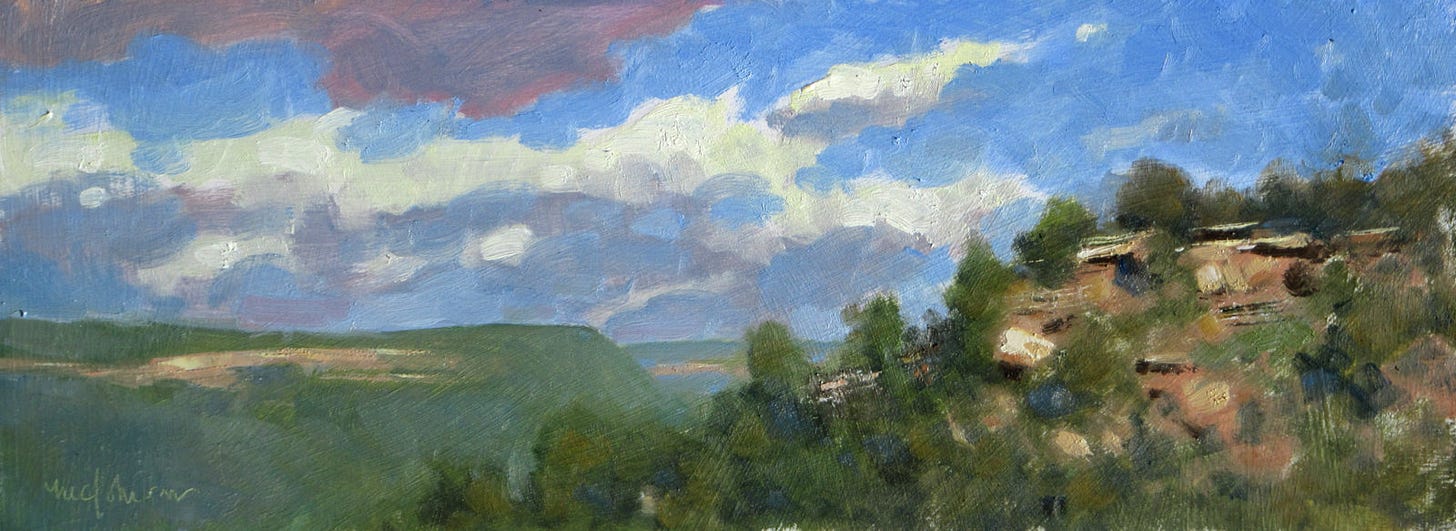
Most of my readers by now should be familiar with how a plein air painting can give a more accurate depiction of a scene than a photograph. Photos lie. Despite a photographer's best effort, a photo will always distort color, value and perspective to some degree. A smartphone, which is the only camera so many of us have these days, is particularly poor in that it oversaturates color to a garish degree; applies an algorithm to capture an unrealistic amount of detail in both light and shadow; and depending on the lens, distorts the proportions of the image. An experienced outdoor painter, on the other hand, can exercise complete control over all of these characteristics to produce an image that is very close to what his eye sees.
But what does his eye see, exactly? An animal's eye sees the world in a way that best benefits that animal. For example, bees see in ultraviolet light, allowing them to discern patterns in flowers that guide them to nectar. But because we humans can't see in the UV range, those patterns are invisible to us. Yet that's for a good reason—we're not nectar-feeders, and the patterns aren't useful. Instead, our hunter-gatherer ancestors needed to find ripe fruit and to stalk prey, so their eyes evolved to see colors with longer wavelengths (reds, yellows) and to detect tiny movements (1/60th of a degree per second) and contrast (our value-detecting rod cells work well at twilight.)
All that said, even between individual humans, what one sees varies greatly. For example, I suffer from deuteranopia, or red-green color blindness. What you perceive as a very pale pink or green looks like a flat grey to me. And because I wear strong prescription glasses (progressives) what you see as a straight line appears to me curved. What's worse, cataracts are ever so slowly developing, and this reduces the amount of contrast I can detect.
The upshot: Our eyes show us only part of the truth. We're missing a lot.
So how does this relate to plein air painting? I often tell my students that a useful exercise is to go out and paint the scene exactly as they see it. Such practice is a great way to hone one's observational and color-mixing skills. (I still do this today.) But does it make an accurate representation of the scene? Does it make a truthful painting?
Here are some thoughts:
Does it make an accurate representation? As I mentioned, everyone's eyes are different. If I observe and paint a scene carefully, the result might look right to me but not to you, so its accuracy is a relative thing and can be debated. But even so, often such a painting disappoints. Paintings that accurately depict the scene can lack the excitement of rich color because so much color in a landscape is muted. (This isn't just my deuteranopia speaking; other experts with better color vision agree.) As I look out my window, I see trees that aren't Krylon Green but some more neutral version, a dull green. The rocks aren't DayGlo Orange but a dull ochre.
Does it make a truthful painting? If I paint the view out my window, I may end up with an accurate painting (to me) but it won't necessarily be truthful. That is, it may not be true to the feeling I had at the moment. I prefer to paint scenes that excite me in some way, but if this "accurate" representation doesn't excite me similarly, then it's not truthful. To help raise the truth level, consider telling a little lie: Push the color, heighten the contrast. This will raise the emotional quality of a scene and thus its faithfulness to your feeling of the moment. (Of course, a mostly grey painting can be exciting, too, but that's a topic for another day.) In lying we might tell the truth.
Be accurate not to the scene in front of you, but to what you feel in your heart. Tell a lie if it helps.



